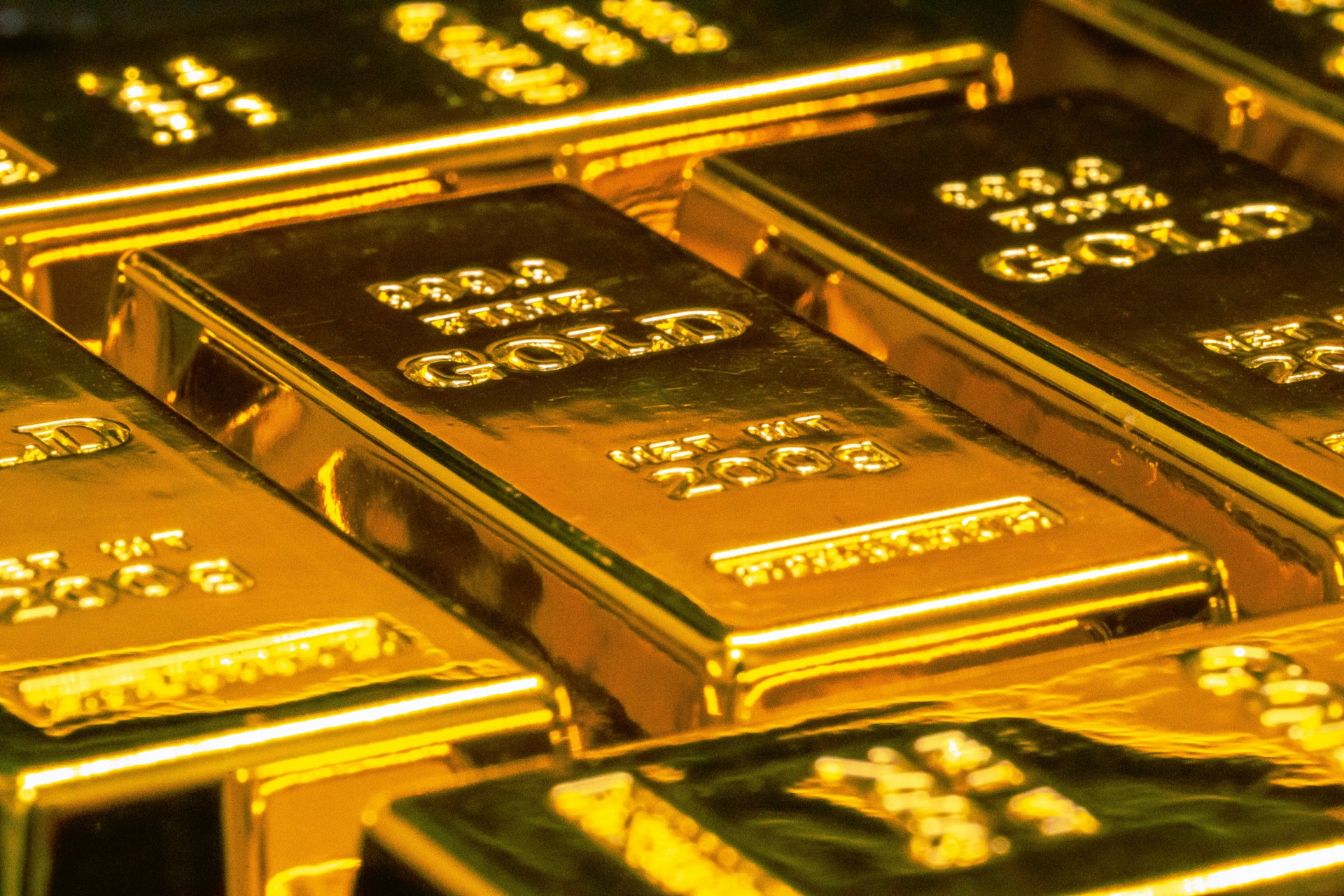Gold Rises as Markets Shift to Safe-Haven Assets Amid Tariff Uncertainty

Gold Rises as Markets Shift to Safe-Haven Assets Amid Tariff Uncertainty
In times of economic uncertainty, investors often flock to assets perceived as safe havens—those that retain or even increase their value when markets are volatile.
One such asset is gold, which has historically served as a reliable store of value during periods of geopolitical tension, inflationary pressures, and financial instability.
Recently, the price of gold has been on the rise, driven by growing concerns over tariffs, trade wars, and global economic uncertainty.
This trend underscores the enduring appeal of gold as a hedge against risk and highlights how investor sentiment can shift dramatically in response to external pressures.
One such asset is gold, which has historically served as a reliable store of value during periods of geopolitical tension, inflationary pressures, and financial instability.
Recently, the price of gold has been on the rise, driven by growing concerns over tariffs, trade wars, and global economic uncertainty.
This trend underscores the enduring appeal of gold as a hedge against risk and highlights how investor sentiment can shift dramatically in response to external pressures.

Gold Rises as Markets Shift to Safe-Haven Assets Amid Tariff Uncertainty
The Role of Gold as a Safe-Haven Asset
Gold has long been considered a "safe-haven" asset due to its intrinsic properties: scarcity, durability, and universal acceptance. Unlike fiat currencies, which can be devalued by central banks through monetary policies like quantitative easing, gold maintains its purchasing power over time.Investors turn to gold when they anticipate economic downturns, currency devaluation, or geopolitical conflicts because it provides a sense of stability in turbulent times.
The recent surge in gold prices reflects a broader trend toward risk aversion among investors. As uncertainty looms regarding tariffs, trade agreements, and the potential for a global recession, market participants are reallocating their portfolios to include more defensive assets. This shift is particularly evident in the commodities market, where gold has outperformed many other investments.
Tariff Uncertainty Fuels Market Anxiety
At the heart of the current market unease lies the issue of tariffs. Tariffs are taxes imposed on imported goods, designed to protect domestic industries by making foreign products more expensive.While tariffs can bolster local economies in the short term, they often lead to retaliatory measures from trading partners, escalating into full-blown trade wars. These conflicts disrupt supply chains, increase costs for businesses and consumers, and create uncertainty about future economic growth.
Recent developments in international trade relations have intensified fears of prolonged tariff disputes.
For example, tensions between major economies like the United States and China have reignited debates over protectionist policies. The imposition of tariffs on key goods has raised concerns about inflation, reduced corporate profits, and slower global GDP growth. In response, investors have sought refuge in assets that are less susceptible to these risks—chief among them, gold.
Why Gold Benefits from Trade Tensions
Gold's performance during periods of tariff-related uncertainty can be attributed to several factors:1. Hedge Against Inflation
Tariffs often lead to higher prices for imported goods, contributing to inflationary pressures. When inflation rises, the real value of cash holdings diminishes, prompting investors to seek alternatives that preserve purchasing power. Gold, with its historical track record of maintaining value during inflationary periods, becomes an attractive option.
2. Currency Depreciation Concerns
Trade wars frequently result in currency fluctuations, as countries may intentionally weaken their currencies to gain competitive advantages in exports. A weaker currency erodes confidence in traditional financial instruments like bonds and equities, driving demand for gold, which is priced in U.S. dollars but retains its value globally.
3. Flight to Safety
When markets experience heightened volatility, investors tend to sell off riskier assets such as stocks and move capital into safer options. Gold's reputation as a stable investment makes it a natural choice during such times. Its lack of correlation with stock and bond markets further enhances its appeal as a diversification tool.
4. Geopolitical Risks
Beyond tariffs, broader geopolitical tensions—such as military conflicts, sanctions, or diplomatic breakdowns—can exacerbate market jitters. Gold benefits from these scenarios because it is seen as a neutral asset unaffected by political decisions or national boundaries.
Recent Trends in Gold Prices
Over the past few months, gold prices have surged significantly, reaching multi-year highs in some cases. This upward trajectory coincides with escalating trade tensions and mixed signals from central banks regarding interest rates. For instance, the Federal Reserve's decision to cut interest rates in response to slowing economic growth has bolstered gold's attractiveness. Lower interest rates reduce the opportunity cost of holding non-yielding assets like gold, making it more appealing compared to bonds or savings accounts.Additionally,macroeconomic indicators suggest that global economic conditions remain fragile. Manufacturing data from major economies has shown signs of contraction, while consumer confidence surveys indicate waning optimism. These factors have reinforced the perception that gold is a prudent investment amid ongoing uncertainties.
Impact on Other Markets
The flight to safe-haven assets like gold has had ripple effects across other financial markets. Equities, particularly those tied to export-driven sectors, have faced downward pressure as investors brace for potential disruptions caused by tariffs. Meanwhile, government bonds—another traditional safe haven—have seen increased demand, pushing yields lower. This dynamic creates a challenging environment for income-focused investors who rely on fixed-income securities for returns.
Cryptocurrencies, often touted as "digital gold," have also experienced heightened interest during this period. However, their extreme volatility and speculative nature make them less reliable than physical gold for conservative investors seeking stability.
Central Banks and Gold Reserves
Another noteworthy trend is the increasing accumulation of gold reserves by central banks around the world. Countries like Russia, China, and India have been actively buying gold to diversify their foreign exchange reserves away from the U.S. dollar. This strategic move reflects growing skepticism about the dominance of the dollar and a desire to insulate national economies from external shocks.
Central bank purchases add upward pressure on gold prices, as large-scale acquisitions reduce the available supply in the market. Moreover, these actions signal confidence in gold's role as a reserve asset, reinforcing its status among private investors.
Challenges and Risks for Gold Investors
While gold offers numerous advantages during uncertain times, it is not without risks. Some challenges to consider include:1. Volatility
Although gold is generally viewed as a stable asset, its price can still fluctuate based on market sentiment, geopolitical events, and changes in monetary policy. Sudden reversals in investor behavior could lead to sharp declines in gold prices.
2. Opportunity Cost
Investing heavily in gold means foregoing opportunities in other asset classes that may offer higher returns during periods of economic recovery. Balancing exposure to gold with other investments is crucial for long-term portfolio health.
3. Storage Costs
Physical gold requires secure storage, which can incur additional expenses. Investors opting for gold ETFs or futures contracts avoid these costs but must contend with counterparty risk.
4. Limited Income Generation
Unlike dividend-paying stocks or interest-bearing bonds, gold does not generate passive income. Its value lies primarily in capital appreciation and preservation, which may not suit all investment objectives.
Looking Ahead: What’s Next for Gold?
The future trajectory of gold prices will largely depend on how ongoing tariff disputes and broader economic trends unfold. If trade tensions persist or worsen, gold is likely to remain in favor as a safe-haven asset. Conversely, a resolution to tariff issues or signs of robust economic recovery could dampen demand for gold, potentially leading to price corrections.Central bank policies will also play a critical role. Further interest rate cuts or expansive fiscal stimulus measures could strengthen gold's position, while hawkish monetary policies might weigh on its performance.
For now, however, the combination of tariff uncertainty, sluggish global growth, and central bank activity continues to support gold's upward momentum. Investors should monitor these factors closely and consider incorporating gold into their portfolios as a hedge against volatility.
Conclusion: Gold Shines in Times of Uncertainty
Gold's recent rally serves as a reminder of its timeless appeal as a safe-haven asset. As markets grapple with tariff-related uncertainty and broader economic challenges, gold provides a beacon of stability for nervous investors. Whether through physical holdings, ETFs, or mining stocks, allocating a portion of one's portfolio to gold can help mitigate risks associated with unpredictable market conditions.In an era defined by shifting geopolitical landscapes and evolving financial paradigms, gold remains a steadfast ally for those seeking to safeguard wealth and navigate uncertainty. By understanding the dynamics driving gold's resurgence, investors can position themselves to capitalize on opportunities while protecting against potential threats.









Report
My comments